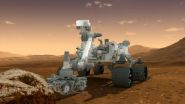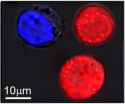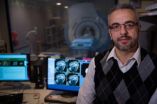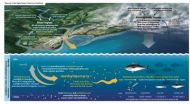(Press-News.org) NASA's Curiosity rover analyzed its first solid sample of Mars in Nov. with a variety of instruments, including the Sample Analysis at Mars (SAM) instrument suite. Developed at NASA's Goddard Space Flight Center in Greenbelt, Md., SAM is a portable chemistry lab tucked inside the Curiosity rover. SAM examines the chemistry of samples it ingests, checking particularly for chemistry relevant to whether an environment can support or could have supported life.
The sample of Martian soil came from the patch of windblown material called "Rocknest," which had provided a sample previously for mineralogical analysis by Curiosity's Chemistry and Mineralogy (CheMin) instrument. CheMin also received a new sample from the same Rocknest scoop that fed SAM. SAM has previously analyzed samples of the Martian atmosphere.
SAM can get a solid sample of Mars from either a drill or a scoop attached to the end of Curiosity's robotic arm. Since Rocknest is essentially a pile of loose soil, the scoop was used this time.
"This is the first time we've analyzed a solid sample using all three instruments that comprise SAM," said Paul Mahaffy, SAM Principal Investigator at NASA Goddard. "We also cleaned Curiosity's sample manipulation system and successfully tested our ability to move the sample from the manipulation system through the instrument suite."
A complex choreography was required to get the sample inside SAM for analysis, according to Mahaffy. First, since the scoop might still have had contamination from Earth, the first three scoops were shaken, run through a sieve, then dumped right back on the surface with the idea that they would carry away any contaminants with them. A sieved portion of the fourth scoop – just a few thousandths of a gram – was then delivered to SAM. A cover that protects SAM from accidentally ingesting windblown material was opened, and Curiosity's arm positioned the sample over SAM's inlet funnels. Before the sample was dropped, SAM turned on its inlet funnel vibrators, which move the sample into a tiny quartz cup. After the sample dropped, the vibrator was turned off, the cover was closed, and the cup, which is on a carousel holding 74 sample cups, was lowered and moved to one of two ovens.
After the sample was baked to release its gases, SAM's three instruments "digested" them and gave Curiosity its first "taste" of Mars. A basic three-step process will be used to analyze future samples as well:
VIDEO:
NASA's Curiosity rover analyzed its first solid sample of Mars with a variety of instruments, including the Sample Analysis at Mars (SAM) instrument suite. Developed at NASA's Goddard Space Flight...
Click here for more information.
Separate the molecules:
Gas from the sample first travels to the Gas Chromatograph (GC) instrument. The purpose of this instrument is to sort out all the different molecules in the sample, and tell how much of each kind there is. It accomplishes this by using a stream of helium gas to push the sample down a long, narrow tube (which is wound into a coil to save space). Helium is used because it is inert, meaning it won't react with and change any of the sample molecules. The inside of the tube is coated with a thin film. As molecules travel through the tube, they stick for a bit on the film, and the heavier the molecule, the longer it sticks. Thus, the lighter molecules emerge from the tube first, followed by the middleweight molecules, with the heaviest molecules bringing up the rear.
Identify the molecules:
Since molecules of different weights emerge from the tube of the gas chromatograph at different times, the GC can send groups of different weights, one at a time, to SAM's next instrument, which will determine exactly what kind of molecule makes up each of the groups. This is the Quadrupole Mass Spectrometer (QMS) instrument. It fires high-speed electrons at the molecules, breaking them up into fragments and giving the molecules and their fragments an electric charge. These molecules and their fragments with an electric charge can be moved by electric fields. The QMS uses both direct current and alternating current fields to sort the electrically charged molecules and fragments based on their weight (mass). Molecules and fragments of different mass are counted by a detector at different times to generate a mass spectrum, which is a pattern that uniquely identifies molecules.
Identify the volatiles and determine the isotopes:
After the QMS identifies the molecules, the sample is directed into the Tunable Laser Spectrometer (TLS), which can identify and analyze certain volatile molecules, like methane and carbon dioxide. The sample enters a chamber with precisely positioned mirrors at both ends. A laser is fired through a tiny hole in one of the mirrors. As the laser light bounces between the mirrors, it illuminates the sample. Different molecules will absorb certain colors (frequencies) of light, so the TLS identifies the molecules by which colors of the laser are blocked (since the laser is tunable, it can be adjusted to shine in a range of colors).
The TLS can also identify isotopes the same way. Isotopes are versions of an element that are a little bit heavier because their nucleus contains more neutrons. For example, carbon 13 is an atom of carbon with an extra neutron, so it is a heavier version of the more common carbon 12. Occasionally, a carbon 13 will take the place of a carbon 12 in an organic molecule. This is important since life prefers to use the lighter isotopes, because chemical reactions with them require less energy. So if we measure the isotopes of carbon in a material and discover that there is more light carbon relative to heavy carbon than would be found randomly, we might guess that we are seeing the effects of life.
Finally, since volatile molecules are found in the atmosphere as well as in soil and rock, samples of the Martian air can be sent directly to the TLS without going through SAM's other instruments.
SAM was developed at NASA Goddard, but with significant elements provided by industry, university, and NASA partners. NASA's Jet Propulsion Laboratory, a division of the California Institute of Technology, Pasadena, manages the Curiosity/Mars Science Laboratory Project for NASA's Science Mission Directorate, Washington. JPL designed and built the rover.
INFORMATION:
For more information about SAM, refer to the "SAM I am" site at: http://ssed.gsfc.nasa.gov/sam/samiam.html
For more information about the Curiosity rover, visit: http://www.nasa.gov/msl and http://mars.jpl.nasa.gov/msl
Curiosity shakes, bakes, and tastes Mars with SAM
2012-12-04
ELSE PRESS RELEASES FROM THIS DATE:
Alzheimer's researcher reveals a protein's dual destructiveness – and therapeutic potential
2012-12-04
A scientist at the University of British Columbia and Vancouver Coastal Health has identified the molecule that controls a scissor-like protein responsible for the production of plaques – the telltale sign of Alzheimer's disease (AD).
The molecule, known as GSK3-beta, activates a gene that creates a protein, called BACE1. When BACE1 cuts another protein, called APP, the resulting fragment – known as amyloid beta – forms tiny fibers that clump together into plaques in the brain, eventually killing neural cells.
Using an animal model, Dr. Weihong Song, Canada Research ...
Search for life suggests solar systems more habitable than ours
2012-12-04
SAN FRANCISCO—Scattered around the Milky Way are stars that resemble our own sun—but a new study is finding that any planets orbiting those stars may very well be hotter and more dynamic than Earth.
That's because the interiors of any terrestrial planets in these systems are likely warmer than Earth—up to 25 percent warmer, which would make them more geologically active and more likely to retain enough liquid water to support life, at least in its microbial form.
The preliminary finding comes from geologists and astronomers at Ohio State University who have teamed up ...
DNA analysis of microbes in a fracking site yields surprises
2012-12-04
SAN FRANCISCO—Researchers have made a genetic analysis of the microbes living deep inside a deposit of Marcellus Shale at a hydraulic fracturing, or "fracking," site, and uncovered some surprises.
They expected to find many tough microbes suited to extreme environments, such as those that derive from archaea, a domain of single-celled species sometimes found in high-salt environments, volcanoes, or hot springs. Instead, they found very few genetic biomarkers for archaea, and many more for species that derive from bacteria.
They also found that the populations of microbes ...
Multitasking plasmonic nanobubbles kill some cells, modify others
2012-12-04
HOUSTON – (Dec. 3, 2012) – Researchers at Rice University have found a way to kill some diseased cells and treat others in the same sample at the same time. The process activated by a pulse of laser light leaves neighboring healthy cells untouched.
The unique use for tunable plasmonic nanobubbles developed in the Rice lab of Dmitri Lapotko shows promise to replace several difficult processes now used to treat cancer patients, among others, with a fast, simple, multifunctional procedure.
The research is the focus of a paper published online this week by the American ...
Listen up, doc: Empathy raises patients' pain tolerance
2012-12-04
A doctor-patient relationship built on trust and empathy doesn't just put patients at ease – it actually changes the brain's response to stress and increases pain tolerance, according to new findings from a Michigan State University research team.
Medical researchers have shown in recent studies that doctors who listen carefully have happier patients with better health outcomes, but the underlying mechanism was unknown, said Issidoros Sarinopoulos, professor of radiology at MSU.
"This is the first study that has looked at the patient-centered relationship from a neurobiological ...
Women with sleep apnea have higher degree of brain damage than men, UCLA study shows
2012-12-04
Women suffering from sleep apnea have, on the whole, a higher degree of brain damage than men with the disorder, according to a first-of-its-kind study conducted by researchers at the UCLA School of Nursing. The findings are reported in the December issue of the peer-reviewed journal SLEEP.
Obstructive sleep apnea is a serious disorder that occurs when a person's breathing is repeatedly interrupted during sleep, sometimes hundreds of times. Each time, the oxygen level in the blood drops, eventually resulting in damage to many cells in the body. If left untreated, it ...
Mercury releases contaminate ocean fish: Dartmouth-led effort publishes major findings
2012-12-04
In new research published in a special issue of the journal Environmental Health Perspectives and in "Sources to Seafood: Mercury Pollution in the Marine Environment"— a companion report by the Dartmouth-led Coastal and Marine Mercury Ecosystem Research Collaborative (C-MERC), scientists report that mercury released into the air and then deposited into oceans contaminates seafood commonly eaten by people in the U.S. and globally.
Over the past century, mercury pollution in the surface ocean has more than doubled, as a result of past and present human activities such ...
Baby's health is tied to mother's value for family
2012-12-04
The value that an expectant mother places on family—regardless of the reality of her own family situation—predicts the birthweight of her baby and whether the child will develop asthma symptoms three years later, according to new research from USC.
The findings suggest that one's culture is a resource that can provide tangible physical health benefits.
"We know that social support has profound health implications; yet, in this case, this is more a story of beliefs than of actual family support," said Cleopatra Abdou, assistant professor at the USC Davis School of Gerontology.
Abdou ...
University of Minnesota researchers find new target for Alzheimer's drug development
2012-12-04
MINNEAPOLIS/ST. PAUL (December 3, 2012) – Researchers at the University of Minnesota's Center for Drug Design have developed a synthetic compound that, in a mouse model, successfully prevents the neurodegeneration associated with Alzheimer's disease.
In the pre-clinical study, researchers Robert Vince, Ph.D.; Swati More, Ph.D.; and Ashish Vartak, Ph.D., of the University's Center for Drug Design, found evidence that a lab-made compound known as psi-GSH enables the brain to use its own protective enzyme system, called glyoxalase, against the Alzheimer's disease process. ...
Western University researchers make breakthrough in arthritis research
2012-12-04
Researchers at Western University have made a breakthrough that could lead to a better understanding of a common form of arthritis that, until now, has eluded scientists.
According to The Arthritis Society, the second most common form of arthritis after osteoarthritis is "diffuse idiopathic skeletal hyperostosis" or DISH. It affects between six and 12 percent of North Americans, usually people older than 50. DISH is classified as a form of degenerative arthritis and is characterized by the formation of excessive mineral deposits along the sides of the vertebrae in the ...




